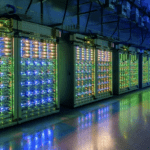By Kennedy Maize
Washington, April 2, 2010 — Greenpeace doesn’t like cloud computing. The out-on-the-edge environmental group also doesn’t much care for Apple’s upcoming IPad computer platform, which adds to the data content of the cloud.
The dirty secret of cloud computing, alleges the environmental group, is that cloud companies are choosing to locate server complexes where Greenpeace doesn’t like the source of the electricity. The report castigates Facebook for locating a server center in Oregon, supplied by PacifiCorp, a utility with major coal-fired capacity. The group also congratulated Yahoo for locating a data hub near Buffalo, N.Y., which gives it access to low-cost hydro-generated electricity. Hydro, of course, is a renewable resource, but is much despised by environmental groups, so kudos for breaking with the green wall on environmentally-correct energy.
The proper path, says Greenpeace, always an advocate of governmental approaches, is for multinationals such as Facebook and Google “and other players in the cloud computing market” to push for “policy change and the local, national and international levels to ensure that, as their appetite for energy increases, so does the supply of renewable energy.”
Says Greenpeace, “With the growth of the cloud, however, comes the an increasing demand for energy.” Greenpeace, like almost every environmental group, completely overestimates the ability of renewables to supplant steady, reliable baseload generation, with coal-fired power in the lead. That’s nothing new.
I’d like to see a careful analysis of the main assertion of Greenpeace, that cloud computing is somehow less energy efficient than the alternative — continued reliance on networks of personal computers, not connected to data centers. I don’t have any data, and I lack the analytic skills to run the numbers, but my intuitive, gut-level suspicion is that cloud computing is far more energy efficient than computer data islands, the alternative approach.
And if that is right, then it strikes me that the best societal approach is to find ways to make the cloud computing paradigm as low-cost as possible. Does that mean coal? Sure. Give me coal-powered data clouds.
In this discussion, it’s important to parse the rhetoric. Greenpeace claims cloud computing involves “massive” data storage and “incredible amounts of energy.” I sure as heck don’t know what those claims mean. What’s not “massive”? How credible is “incredible”? Let’s get specific here. Incredible, by the way, means “too extraordinary and improbable to be believed,” according to my dictionary. It’s not a useful term when it comes to descriptions of power demands of data centers.
Iwant to hear from readers on this subject. Am I right? Do I know what I’m talking about? Am I full of it? Fire away, and provide data that is neither “massive” nor “incredible”.








